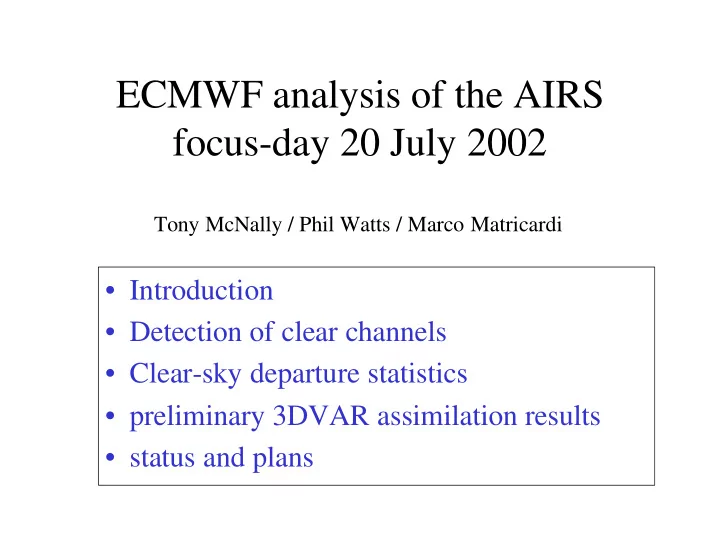

ECMWF analysis of the AIRS focus-day 20 July 2002 Tony McNally / Phil Watts / Marco Matricardi • Introduction • Detection of clear channels • Clear-sky departure statistics • preliminary 3DVAR assimilation results • status and plans
ECMWF cloud detection algorithm for AIRS Observed cloudy spectra and •Exploits NWP model accuracy simulated clear-sky (NWP) spectra (particularly in mid-upper trop constrained by AMSUA) Channels split into bands •Aims at dynamically finding (LW/SW/6m/O3) by cloud effect clear channels rather than completely clear locations Non-linear transformation to • So far validated with simulated cloud-ranked channel space cloudy AIRS radiances •Extendable to CrIS / IASI Pattern recognition algorithm (currently digital filter used)
ECMWF cloud detection scheme (example for LW band from AIRS focus day) Observed - computed radiance departures Cloudy channels Clear channels
Distribution of data flagged clear AIRS channel 145 ( 14.5micron similar to HIRS AIRS channel 1694 ( 6.7micron similar to HIRS channel 3 100hPa ) channel 12 400hPa ) AIRS channel 226 ( 13.5micron similar to HIRS AIRS channel 787 ( 11 micron similar to HIRS channel 5 600hPa ) channel 8 window )
ECMWF detection of clear channels AIRS channel 145 ( 14.5micron similar to HIRS channel 3 100hPa ) clear cloudy
ECMWF detection of clear channels AIRS channel 1694 ( 6.7micron similar to HIRS channel 12 UTH ) clear cloudy
ECMWF detection of clear channels AIRS channel 226 ( 14.0micron similar to HIRS channel 5 600hPa ) clear cloudy
ECMWF detection of clear channels AIRS channel 787 ( 11micron similar to HIRS channel 8 window ) clear cloudy
Frequency of AIRS channels flagged CLEAR (Longwave Band only)
Frequency of AIRS channels flagged CLEAR (Whole AIRS spectrum)
AIRS clear-sky radiance departures from the ECMWF model The ECMWF model fields (T/Q/O3) are interpolated to the AIRS locations and are valid to within 1hour of the observation time. Clear-sky radiances for each AIRS channel are then computed using the RTTOV radiative transfer model using SRFs supplied by L.Strow. The statistics are: (Observed AIRS radiance) minus (ECMWF-RT)
AIRS radiance departures from ECMWF model
AIRS radiance departures from ECMWF model Stratospheric +ve ECMWF model bias suggested by other instruments
AIRS radiance departures from ECMWF model Negative (moist) bias suggested by other instruments
AIRS radiance departures from ECMWF model RTTOV on 43 levels No solar radiation currently modeled
Preliminary assimilation of real AIRS radiances Experimental details: •Assimilation scheme : 3DVAR •Assimilation window : 6hrs •Model resolution : TL159 (60 levels) •Data used : All conventional + AIRS radiances •AIRS channel selection : clear only from 281 NRT •Observation errors : 1.0K in each channel
Channel use in 3DVAR assimilation based on clear flags Temperature weighting functions Tail pressure of lowest AIRS long-wave channel determined cloud-free High level (2002-07-20 real AIRS radiances) cloud cover Mid-level cloud cover Low cloud or clear
Temperature increments in ECMWF 3DVAR due to AIRS clear channel radiance assimilation Temperature increments in (K) at 200hPa for 2002-07-20 for 06z (red orange positive / green-blue negative) The plots shows the active use of channels above low cloud causing temperature adjustments to the analysis in the mid-upper troposphere AIRS-787 window channel (obs-fg )
Summary of results for AIRS focus-day •Cloud detection of clear AIRS channels working well but requires detailed validation with MODIS imagery •Instrument radiance data generally simulated very well from NWP model using RTTOV radiative transfer (soon to be upgraded to 90 levels + new spectroscopy) •Preliminary assimilation looks very encouraging, but sensible NWP impact trials pending NRT data flow and final SRFs.
Current schedule for AIRS assimilation at ECMWF •Focus day (2002-07-20) data released by NASA in late August •Analysis of focus day data (in progress) •Initial re-tune of RT model (complete) •NRT data activated by NESDIS ORA (October 2002) •Activation of real-time monitoring results on ECMWF WWW •Second (final ?) retune of RT model from NASA (end of 2002) •Residual bias evaluation / correction •NRT assimilation to evaluate NWP performance (spring 2003) •Day-1 (conservative) Operational assimilation (late spring 2003)
Notes: Low pass filter : d i i low is the channel ranked most sensitive to cloud Initialize •the gradient is evaluated over i = i low (+1) and (+5) steps to avoid stopping as local max/min. The threshold is 0.001 ? The gradient is checked negative increment over cold surface and positive i = i + 1 over warm surfaces. •window channels are no excluded that show surface (e.g. emissivity) features more Grad (i) < m than a monotonic cloud signal and and cause dangerous d(i) < t termination when the clear-sky emission is poorly computed. yes •the departure threshold is + / - 0.5K depending on surface flag > I clear type flag < I cloudy
Recommend
More recommend